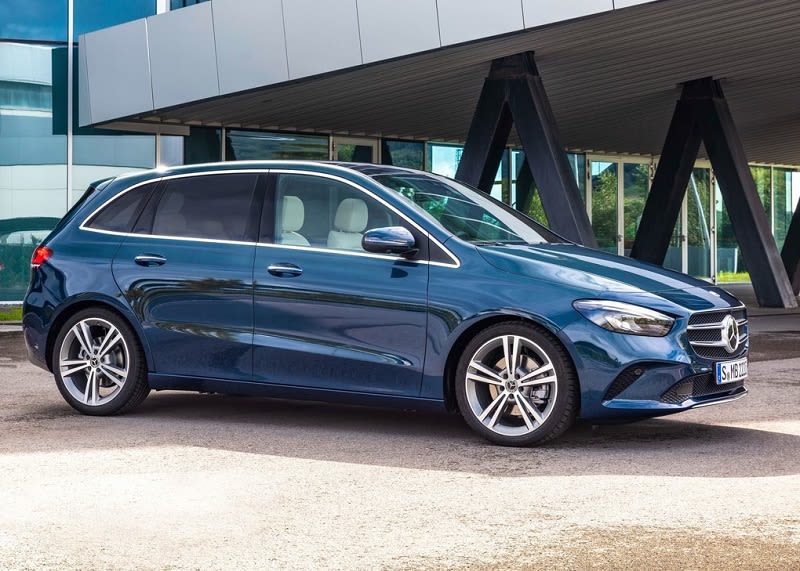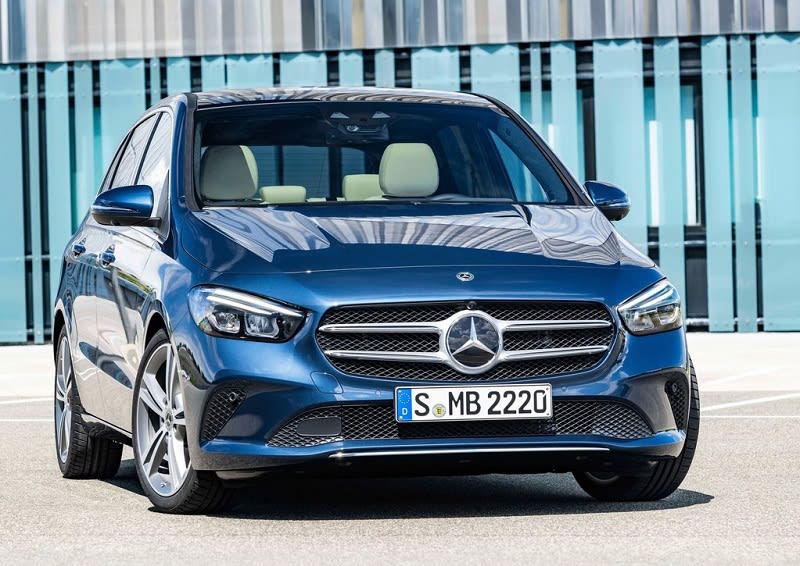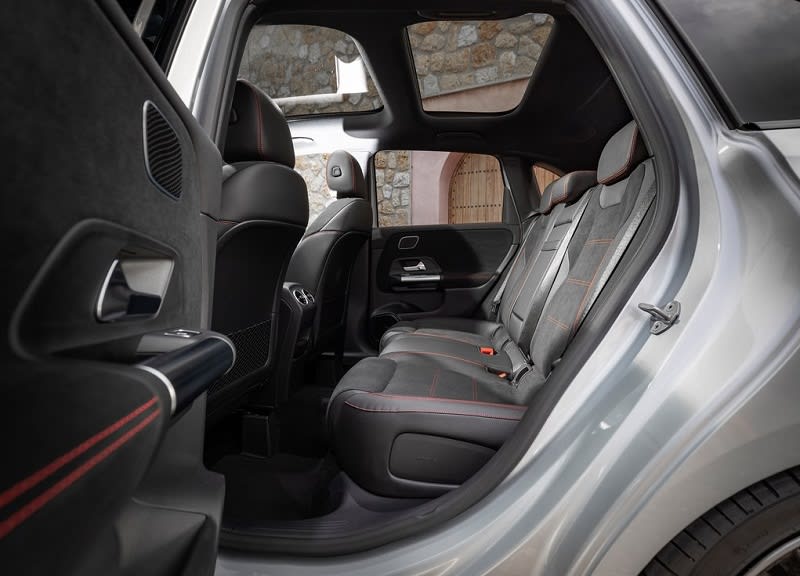.jpg)
Mercedes-Benz B-Class Review
.jpg)
Introduction
The B-Class is a small MPV-like hatchback from Mercedes-Benz that fits logically into its letter-named line-up. Where the A-Class is the brand’s standard Ford Focus-sized family car, the B-Class physically expands things a little. It’s similar to the A-Class in a lot of ways, and takes up about the same space on your driveway, but the design has been tweaked for practicality, with more room for passengers and luggage without compromising the tech-filled luxury that the Mercedes badge promises.
Review Sections
Select's rating score* - 4.3 / 5
At a Glance
We’re big fans of the Mercedes A-Class, which nails the premium hatchback recipe with some smart looks, a quality interior and lots of the latest technology. But if there’s any issue with it, it’s that it’s on the small side. For most A-Class customers, that’s not a problem, but if you’re set on a small car, yet need as much space inside as physically possible, you could find things a bit tight.
That’s where the B-Class comes in. It takes the same mechanical underpinnings at the A-Class but changes the design to make it more practical, with more interior space. In doing so, Mercedes has created a rival for cars like the BMW 2 Series Active Tourer, although the B-Class lacks the BMW’s seven-seat option. Still, it’s loaded with the same latest infotainment technology as the A-Class, boasts a range of petrol and diesel engines and a plug-in hybrid (PHEV) version, and has several well appointed trim levels to choose from. The public might be falling in love with small SUVs, but the B-Class shows that there’s still plenty to like about a small people carrier.

Key Features
The B-Class’s big selling point is its extra space over the A-Class, and it does this largely through height; it’s considerably taller than the A-Class, but the same length and width. Despite its focus on practicality, the designers have done a remarkably good job of making the B-Class look good. Not many MPVs would feature on any best-looking cars lists, but the Mercedes manages to still look classy and sleek.
The interior is largely unchanged from the A-Class in terms of features – you still have a huge screen and jazzy air vents dominating the dashboard and some top quality materials. But there’s more headroom for passengers front and back, and the rear seats will slide forward or backwards, with 140mm of adjustment. Perfect for when you have particularly leggy passengers, or extra luggage in the boot.
Apart from the petrol and diesel options, there’s also a PHEV option, which could be of particular appeal to company car users due to low CO2 emissions and therefore low company car tax.
All that, and there are plenty of well-equipped trim levels to suit different budgets, and each one feels like a proper Mercedes.
Performance & Drive
The B-Class can be specced with any one of a range of petrol and diesel engines. All of them have enough grunt to easily cope with day-to-day duties, and a few have extra oomph if you regularly drive a fully loaded car. Unlike the A-Class, or most other cars in the Mercedes range, there are no performance-focused AMG models.
The petrol range starts with the B180, which uses a 1.4-litre engine with 134bhp. Should you need more power, there’s the B200 with 161bhp. This has a good amount of punch to it, but you might find you need more revs than expected to get the most out of it. That can make it rather noisy, too.
If you’re doing mostly longer journeys, consider a diesel model. These can be more expensive to lease, but will get better fuel economy. If you do enough miles, the fuel savings can offset the extra cost. The diesel range starts with the B180d, which has a 1.5-litre engine putting out 114bhp. Next up is the 200d, powered by a 2.0-litre engine with 148bhp, which we think is the sweet spot, with lots of grunt available low down in the rev range that makes acceleration feel relatively effortless. There’s also the B220d with 187bhp if you really want extra zip.

The top-spec powertrain comes in plug-in hybrid form. The B250e PHEV combines a 1.3-litre petrol engine with an electric motor and 10.6kWh battery, giving it an electric-only range of 42 miles. If you do mostly shorter journeys and have somewhere to plug it in and keep the battery charged, this could dramatically reduce your fuel bills. It’s also the most powerful B-Class, with an output of 215bhp. That means brisk acceleration, although it’s still not a sporty car.
None of the B-Classes are geared up to be particularly engaging to drive, but that said, they’re all surprisingly nimble; much like the A-Class, in fact. Higher spec cars have more sophisticated suspension, but all versions feel confident and composed whether you’re driving around town, cruising on the motorway or threading through country roads. The ride for some might be on the firm side, particularly on AMG Line trims, but it’s not too bad. If you’re after something a bit more supple, the BMW 2 Series Active Tourer is worth looking at.
Running Costs
Leasing costs for the B-Class are broadly in line with the BMW 2 Series Active Tourer, although as always, keep an eye out for regular special offers that mean you can snap up a bargain from one or the other. At the time of writing, the B250e PHEV jumps out as being particularly affordable compared to the petrol or diesel models, which isn’t always the case. BMW’s 225xe PHEV is considerably more expensive per month.
When it comes to fuel, the PHEV has the potential to get you by far the best economy, as long as you use it properly. Keep it charged and rely on electric power, and you can make a tank of petrol last for ages. But if you don’t, you’ll waste fuel hauling heavy, empty batteries around. The official fuel consumption figure for the B250e is 235.4mpg, but this is based solely on a lab test, and will vary by usage. Charging takes around two to three hours using a home wall box.
For longer journeys, diesel could be the way to go. Depending on the model you go for, leasing costs aren’t much higher than petrol cars, and fuel economy will be better. The B180d promises up to 54.4mpg, the B200d even better despite its extra power; up to 55.4mpg. The B220d has an official figure of up to 54.3mpg.
The petrol models will be better suited to around town duties, with fuel economies of up to 45.6mpg for both the B180 and B200.
Insurance groups aren’t particularly low, due in part to the premium brand and levels of equipment. They start at 19 for the B180d and rise to 30 (of 50) for the B220d. The insurance group for the B250e hadn’t been confirmed at the time of writing.

Emissions
If you’re looking for the B-Class with the lowest CO2 emissions, then the B250e PHEV is the one to go for. Official emissions of 27g/km put it in the 7% bracket for benefit-in-kind company car tax in 2021/22.
In the diesels, the B180d emits between 137 and 138g/km depending on trim, meaning it’s in the 31% bracket, while the B200d emits less – between 134 and 135g/km, putting it in the 30% bracket for all models except the top-spec AMG Line Premium Plus model. The B220d emits between 136 and 137g/km, both of which sit in the 31% bracket. This all means that a B200d is the most frugal model, as long as you don’t get it fully-loaded. All the diesel engines are RDE2 standard compliant, which means they don’t attract the 4% diesel surcharge for non-compliant models.
For petrol cars, both the B180 and B200 emit between 140 and 142g/km, which means they sit in the 32% bracket.
Interior
The design of the B-Class’s interior is lifted wholesale from the A-Class, but that’s no bad thing at all. So often, MPVs and practical cars all but ignore how the interior looks, but this is a very smart environment in which to sit. Big turbine-like vents dominate the dashboard, alongside a wide screen that looks like a tablet and houses myriad infotainment features. Build quality is generally very good indeed, although the odd cheap-feeling bit is disappointing. We’re looking at you, indicator stalks. The seating position is higher than in the A-Class, reflecting the preferences of previous B-Class customers who like a loftier perch.
Technology
Mercedes’s latest infotainment system, called MBUX, is one of the best on the market. Its highlight feature is a digital assistant, very much in the mould of Siri or Alexa. Just say ‘Hey Mercedes’ and you can ask it to do all manner of functions, from inputting a sat-nav destination to changing the temperature. It’s far more advanced than a lot of rival systems, and one of the few that works as it’s supposed to. You’ll get sat-nav, DAB radio and Bluetooth on all models.
Entry-level cars get a 7.0-inch screen in the centre while the rest have a 10.25-inch version. All models also get a digital instrument panel, rather than conventional analogue dials. This allows for plenty of configuration to show your preferred driving information, whether that be sat-nav directions, fuel economy, range or many others. Again, this is 7.0 inches or 10.25 inches depending on the model. It all works together very well, and looks great too.
Another flashy feature is the augmented reality navigation, which comes as standard on AMG Line Premium and AMG Line Premium Plus models. This uses a front-mounted camera to give a live feed of the road ahead on the screen, overlaid with large directions, making it almost impossible to miss the route ahead. It works well and looks great, but some might view it as more of a gimmick than an essential feature.
Practicality & Boot Space
This is the B-Class’ trump card, and it plays it well. It might not be a large car but the space it does have has been maximised, with lots of cupholders, door pockets and cubby holes spread throughout the car to keep holds of odds and ends. You should easily fit three adults in the back, as long as the person in the middle doesn’t have very long legs.
When compared to the BMW 2 Series Active Tourer, there’s no seven seat option and a slightly smaller boot at 455 litres. That drops to 405 litres in the B250e PHEV, due to extra electrical components. But each rear seat can move forward or backwards to give more legroom or boot space, depending on what you need, and that can expand the boot to up to 705 litres or 1,540 litres if you fold them all down. That’s plenty of room to carry larger items.
Safety
The B-Class was tested by independent safety organisation Euro NCAP in 2019, and scored the maximum five stars. All versions come with plenty of the latest bits of safety technology, including automatic emergency braking, which will apply the anchors if you don’t respond to an impending crash. You’ll also get front, side and curtain airbags as well as a knee airbag for the driver, and the option of two rear side bags if you want them. There are two Isofix child seat mounting points on the outer rear seats.
Optional safety kit includes automatic steering and a system that will warn you of vehicles lurking in your blind spot.

Options
There are an impressive six trim levels to choose from in the B-Class, which should make it relatively straightforward to pick a model that suits your needs and budget.
The Sport model might be the entry-level version, but it comes with a very decent level of equipment, including 17-inch alloy wheels and bright LED headlights, as well as an electric boot lid and keyless entry and engine start. Dual-zone climate control air conditioning is also included, and the seats are upholstered in synthetic leather.
Upgrade to the Sport Executive model and you’ll get a parking package, which comprises a reversing camera and parking sensors both front and back, as well as the larger 10.25-inch infotainment screen. Importantly for many, you’ll also get Apple CarPlay and Android Auto for smartphone connectivity, which isn’t included on the Sport.
The Exclusive model has 19-inch wheels and has had the badges removed for a smoother look. It comes with a red metallic paint and a Multibeam LED set of headlights, which let you use full beam without dazzling oncoming cars. You also get a panoramic sunroof, wood interior trim and a Burmester sound system.
Then there’s the AMG Line Executive model, which is a step up from the Sport Executive and has 18-inch wheels and a body kit inspired by Mercedes’ tuning division, AMG. It’s sportier-looking as you might expect, and has sports seats inside to match.
AMG Line Premium, meanwhile, has the augmented reality navigation feature, the larger digital instrument panel and an upgraded sound system. Top of the range is the AMG Line Premium Plus, which is fully loaded with most of the features previously mentioned, from Multibeam LED headlights to the panoramic sunroof.
Optional extras include various metallic paint colours and the Driving Assistance Package, which adds a suite of systems to help the car drive semi-autonomously on the motorway. It combines adaptive cruise control and steering assistance to make life a bit easier.

Rival Cars
The only real close rival to the B-Class is another premium hatchback-cum-MPV, the BMW 2 Series Active Tourer. Many other cars that used to take a similar approach, such as the Toyota Prius+ and the Volkswagen Golf SV are no longer on sale, as consumers increasingly turn to SUVs rather than MPVs like this. That said, some 2018 Prius+ stock was still available to lease at the time of writing.
Still, there are plenty of other cars that you might consider, depending on where your priorities lie. If you’re set on a people-carrying small Mercedes but need seven seats, then the GLB SUV could be an option, while the BMW does offer seating for seven but lacks the style of the B-Class.
Other high-end cars of a similar size include the excellent Volvo XC40 SUV, while if you’re set on an MPV then consider some of the larger cars like the Ford S-Max, Peugeot Rifter and Citroen Berlingo. They’re not as sexy as the Mercedes, but they’ll haul a lot of people and cargo.
Verdict & Next Steps
The small luxury MPV market is contracting, and is down to a field of just two – the B-Class and the BMW 2 Series Active Tourer. The BMW might be able to take more people, but for our money the B-Class is the more stylish choice. Being based on the A-Class hatchback makes it less utilitarian and surprisingly decent to drive, yet it’ll still house passengers in plenty of comfort considering its diminutive size. On top of that, it’s well put together with a broad range of power and trim options. We don’t blame you if you decide to go down the SUV route, like so many people do these days. But the B-Class shows there’s plenty of life in the MPV yet.
Where to next?
View latest Mercedes-Benz B-Class leasing deals - from £301.34 per month inc VAT**
Looking for a great leasing deal? Check out our incredible range of Special Offers
New luxury MPV? Read our latest Car Reviews and find the right model for you
Want to know more about leasing? Take a look at our comprehensive Leasing Guides
Interested in everything motoring? Why not catch up on all the latest Car Leasing News.
*Score based on Select’s unique meta score analysis, taking into account the UK’s top five leading independent car website reviews of the Mercedes-Benz B-Class
**Correct as of 08/03/2021. Based on 9 months initial payment, 5,000 miles over a 48 month lease. Initial payment equivalent to 9 monthly payments or £2712.05 Ts and Cs apply. Credit is subject to status.





















